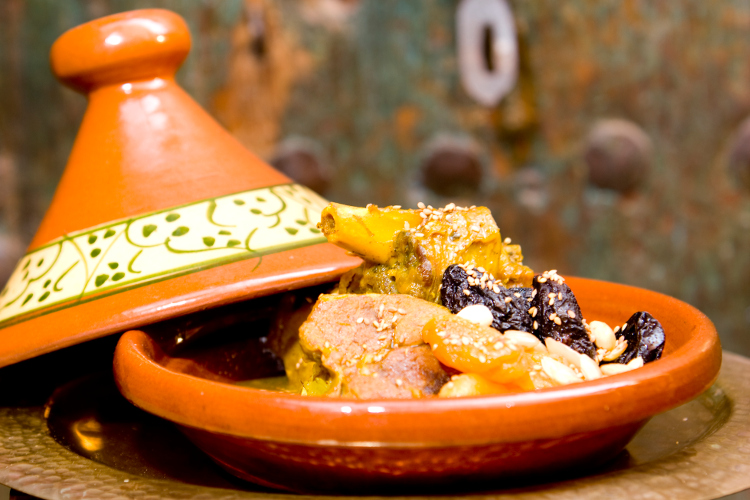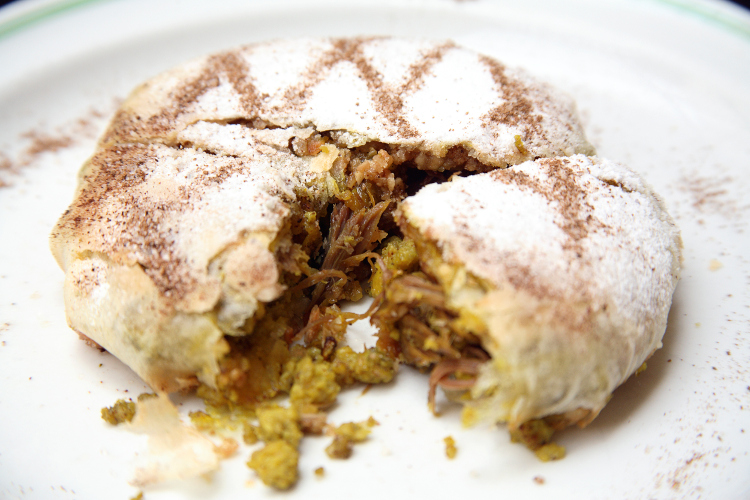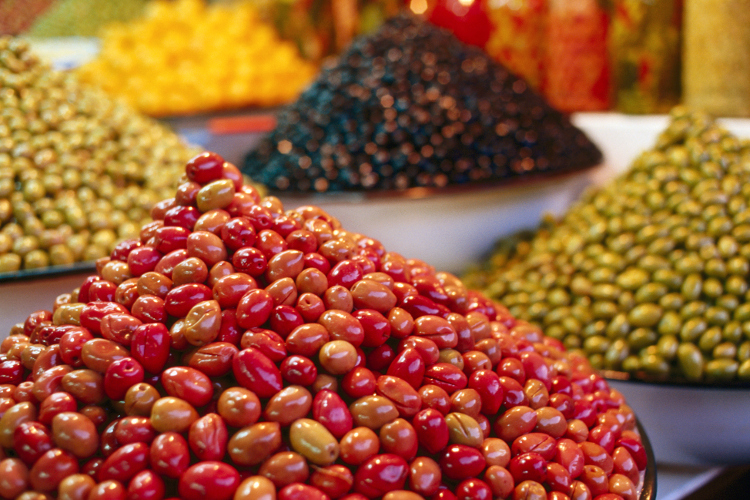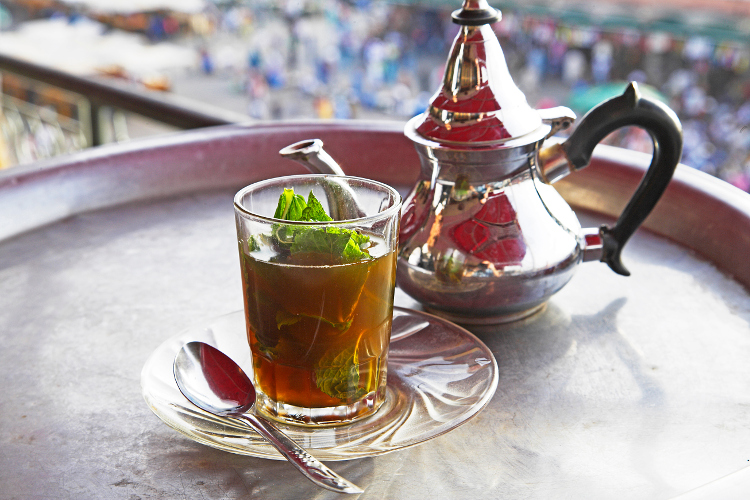Tagine
Tagines, named after the conical clay cooking pot they’re cooked in, are on every Moroccan menu, from roadside cafés to palatial dining rooms. It’s a stew of tender meat and vegetables in a blend of spices, sometimes with the addition of olives and preserved fruit, and is always served with bread. Try the kefta variety, where lamb or beef mince is rolled into balls, cooked in a tomato and onion sauce and topped with an egg.

Tanjia
Tanjia is another dish that owes its name to the clay pot in which it’s cooked. Traditionally made by single men, large chunks of beef or lamb and a selection of spices are stuffed into the pot, which is topped with a paper lid and tied with string. It’s then taken to the local hammam (or bathhouse) where it’s propped in the embers of the furnace that heats the water to slow cook for hours.
Couscous
Dating back to the 13th century and probably Berber in origin, couscous is Morocco's quintessential dish. It’s traditionally a time-consuming process, where semolina grain is laboriously hand rolled before being steamed. When the grains are plump and fluffy, it’s served piled high with meat and vegetables, nuts and dried fruit. It’s usually prepared on Fridays, the Muslim holy day, and for weddings, funerals and at the end of Ramadan.
Pastilla
This Fassi (from Fez) speciality is a mix of sweet and salty flavours thought to have been brought to Morocco from Andalucia by the Moors. This elaborate pie is traditionally made with pigeon cooked in spices, topped with a layer of toasted and ground almonds and cinnamon, all wrapped in warka pastry, similar to phyllo. It’s more likely to be made with shredded chicken today but try the original version if you get the chance.

Harira
This traditional Berber soup is rich and flavoursome and while it’s often served as a starter, it’s filling enough to be a meal in itself. The recipe varies from region to region but the basic stock includes flour, chickpeas, tomatoes, lentils, spices and a small amount of lamb or chicken, finished off with a squeeze of lemon juice and turmeric. During Ramadan it’s served at dusk to break the fast, often with the sweet and sticky pretzel-like chebakkiya.
Bread
In Morocco, every neighbourhood has five things; a mosque, a school, a hammam, a fountain, and a communal wood-fired oven, or farine. Families take their own dough to be baked or buy direct from the baker, who regularly make around 2,000 of the khobz – Morocco’s staple round, crusty loaf – each day. Other traditional breads include harcha, made from pan-fried semolina; rghaif, a flaky, layered flat bread, and baghira, spongy and full of holes like a crumpet.
Salads
Moroccan meals often begin with a vegetarian-friendly spread of colourful small salads, raw and cooked, hot and cold, and perfect for sharing. Dishes include salade marocaine, finely chopped tomatoes, onions and cucumber; a smoked aubergine dip called zaalouk, seasoned with garlic, paprika and cumin; finely grated carrots with freshly squeezed orange juice; courgette purée; taktouka, a cooked tomato and roasted pepper salad, and plump, local olives.

Sweets
Fresh fruit usually ends most meals but Moroccans are passionate about sweet things and the souks are filled with calorie-laden treats. There are rich pastries like briouats, deep-fried filo pastry triangles stuffed with almond paste, and gazelle horns, crescent-shaped pastries with almond paste scented with orange flower water and cinnamon; and shebakia, flower-shaped, fried sesame biscuits and crunchy biscotti-like fekkas. If you’re in Moulay Idriss, don’t miss the famous nougat.
Tea
Mint tea is the national drink, often jokingly referred to as Berber whiskey. A sign of hospitality, preparing it is an art form: green tea is flavoured with sprigs of fresh mint and normally served with lots of sugar. In winter, when mint is scarce, bitter wormwood – also known as absinthe or sheba – is used. It’s usually poured from metal teapots into glasses from a great height, and the resulting bubbles are meant to make it more appealing.

Spices
You’ll find colourful pyramids of aromatic spices in every souk, including saffron that was once worth more than gold. Moroccan speciality Ras El Hanout is a complex blend of up to 30 ingredients prepared by grinding together whole spices, dried leaves and roots, including cardamom, nutmeg, cinnamon, ginger and turmeric. Usually reserved for special dishes, the literal translation from Arabic is ‘top of the shop’, or the best the shop has to offer.
Don't miss a chance to grab these on-the-go snacks, which are sold in markets and from food stalls across the country
Camel spleen: Gamey tasting camel spleen is stuffed with ground camel meat, and sometimes beef or lamb, olives, spices and a dash of hump fat. The sausage-like form is baked in a communal bread oven before being sliced, cooked on a griddle and served up in a khobz sandwich.
Sheep’s head: Medina stalls serve steamed sheep’s head, dished up with cumin, salt and chilli. Almost all the meat is edible but the cheeks and toungue are particularly tender. Nothing goes to waste and other stalls will have pots filled with sheep’s brain bubbling away in a rich tomato sauce.
Snail soup: Snails can be found all over Morocco, usually in a spicy soup served from a cart in the medina. They don’t use the large French variety but small snails known as babouche. Eat them with a toothpick or just buy a bowl of the tasty broth that the snails are cooked in.
Bisara: Also called talakhcha, this is a thick soup, especially popular at breakfast time. Made from dried and peeled fava beans or broad beans, it’s served topped with a generous drizzle of olive oil, a sprinkling of red-hot chilis or cumin and a freshly baked khobz.
Sardines: Morocco is the largest tinned sardine exporter in the world but fresh ones make a tasty medina snack. They’re best stuffed with tangy chermoula paste, a mix of spices, including cumin and paprika, fresh coriander and lemon juice, dusted with flour and deep fried.